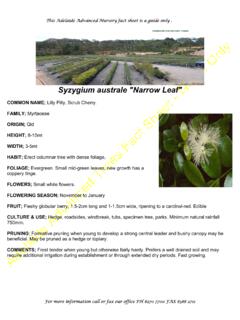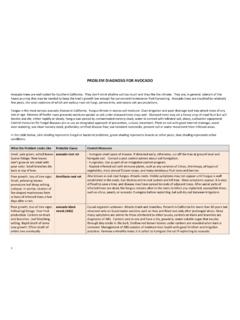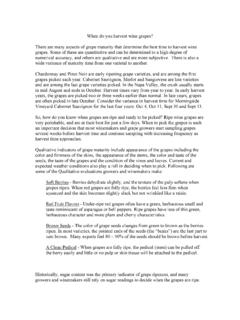Transcription of Ethylene and fruit ripening: From illumination gas …
1 Genetics and Molecular Biology, 29, 3, 508-515 (2006). Copyright by the Brazilian Society of Genetics. Printed in Brazil Review Article Ethylene and fruit ripening : from illumination gas to the control of gene expression, more than a century of discoveries Ana L cia Soares Chaves1 and Paulo Celso de Mello-Farias2. 1. Departamento de Bioqu mica, Instituto de Qu mica e Geoci ncias, Universidade Federal de Pelotas, Pelotas, RS, Brazil. 2. Engenharia de Bioprocessos e Biotecnologia, Universidade Estadual do Rio Grande do Sul, Novo Hamburgo, RS, Brazil. Abstract The effects of Ethylene on plants have been recognized since the Nineteenth Century and it is widely known as the phytohormone responsible for fruit ripening and for its involvement in a number of plant growth and development pro- cesses.
2 Elucidating the mechanisms involved in the ripening of climacteric fruit and the role that Ethylene plays in this process have been central to fruit production and the improvement of fruit quality. The biochemistry, genetics and physiology of ripening has been extensively studied in economically important fruit crops and a considerable amount of information is available which ranges from the Ethylene biosynthesis pathway to the mechanisms of perception, signaling and control of gene expression. However, there is still much to be discovered about these processes and the objective of this review is to present a brief historic account of how Ethylene became the focus of fruit ripening re- search as well as the development and the state-of- art of these studies at both biochemical and genetic levels.
3 Key words: climacteric fruits, plant hormones, Ethylene biosynthesis, ripening , signal transduction. Received: December 15, 2004; Accepted: December 14, 2005. History of Ethylene Research zontal growth of etiolated pea seedlings which he had been Nineteenth Century coal gas ( illumination gas), pro- cultivating. Several observations were subsequently made duced from the partial combustion of coal, was an impor- on the effects of illumination gas on plants and the typical tant source of light. In 1858, Fahnestock attributed the symptoms of Ethylene action described, including the inhi- deterioration of a collection of plants cultivated in a Phila- bition of stem and root growth, leaf abscission, horizontal delphia greenhouse and showing signs of senescence and growth and plant senescence.
4 In 1924, Denny demonstrated leaf abscission to the presence of illumination gas, but al- that smoke from kerosene combustion in lanterns used to though he detected the presence of hydrocarbons he was de-green citrus fruits contained Ethylene as the active ingre- unable to identify the component responsible for such ef- dient and demonstrated that Ethylene is a fruit - ripening fects. Some years later, in 1864, Girardin verified that trees agent that acts in very small amounts. All these observa- growing close to places where illumination gas was leaking tions were in agreement with numerous historic reports, showed the same symptoms of senescence, and also dem- such as those from China where incense was burnt in closed onstrated that Ethylene was present in this gas.
5 In fact, illu- chambers to activate the ripening of pears (Zegzouti, 1997). mination gas contained 5% Ethylene and its physiological In the 1930s most of the physiological effects of eth- effects on plants had been observed for many years without ylene on plants had already been described (Pech et al., being formally attributed to illumination gas (Zegzouti, 1992) and after this period Ethylene became the object of 1997). numerous studies due to commercial interest related to its In 1886 Neljubov discovered that Ethylene was the bi- action on the ripening and conservation of fruit . After a ologically active component of illumination gas when he long time using Ethylene in growth and development ma- noticed that illumination gas was responsible for the hori- nipulations, it was presupposed that this gas was an endoge- nous growth regulator.
6 The chemical proof that plant tissues naturally produce Ethylene was provided in 1934 by Send correspondence to Ana L cia Soares Chaves. Departamento de Bioqu mica, Instituto de Qu mica e Geoci ncias, Universidade Gane in an experiment involving the collection of gas emit- Federal de Pelotas, Campus Universit rio s/n , Caixa Postal 354, ted by ripening apples. Later it was demonstrated that a 96010-900 Pelotas, RS, Brazil. E-mail: strong increase in Ethylene production was associated with Chaves and Mello-Farias 509. peak in respiration during tomato ripening (Zegzouti, 1997). All these reports on biological activity of Ethylene led scientists to consider this endogenous growth regulator as a plant hormone (Abeles et al.)
7 , 1992) produced by plants in amounts that can reach 500 nL g-1 h-1 but is active at very low concentrations from 10 to 100 nL L-1. A number of studies have demonstrated the intervention of this hormone in several phases of plant growth and development, such as fruit ripening (Abeles et al., 1992), seed germination, leaf and flower senescence and abscission, root growth and de- velopment, leaf and flower senescence and somatic embryogenesis. It is also known that Ethylene is synthe- sized in response to different type of stress, such as wound- ing, very low and very high temperatures, flooding or drought, treatments with other hormones, heavy metals and attack by pathogens (Pech et al.
8 , 1992). The Ethylene biosynthesis pathway has now been completely elucidated due to advances in the techniques of biochemical analyses (Yang and Hoffman, 1984; Kende, 1993) (Figure 1). The first step of this metabolic pathway involves the conversion of S-adenosyl-L-methionine (SAM) to 1-aminocyclepropane-1-carboxylic acid (ACC), catalyzed by the enzyme ACC synthase (ACCS). The sec- ond step, catalyzed by ACC oxidase (ACCO), consists in the conversion of ACC to Ethylene , CO2 and HCN. Alterna- tively, ACC can be malonylated, producing N-malonyl ACC by the action of N-malonyl transferase (NMT), reduc- ing substrate availability for ACCO.
9 In some specific cases, Ethylene regulates its own production (auto-catalytic biosynthesis) inducing de novo synthesis of ACCS and Figure 1 - Ethylene biosynthesis pathway (yellow) and its relationship to ACCO (Yang and Hoffman, 1984). The genes encoding the methionine cycle (green). ACC: 1-aminocyclopropane-1-carboxylic these two enzymes have been cloned and characterized in acid; ACCS: ACC synthase; ACCO: ACC oxidase; Ade: adenosine; ADP: several plant species and are known to belong to multigenic adenosine 5'-diphosphate; ATP: adenosine 5'-triphosphate; CMB: 2-keto-4-metilbutyrate; MTA: 5'-metilthioadenosine; MTR: 5-metilthio- families whose members show strongly regulated expres- ribose; MTR-1-P: 5-metilthioribose-1-phosphate; N-MACC: N-malonyl sion (Kende, 1993) and are differentially expressed in re- ACC; NMT: N-malonyl transferase.
10 SAM: S-adenosyl methionine (adap- sponse to external stimuli including flooding, infection by ted from Yang and Hoffman, 1984). pathogens and wounding as well as internal stimuli such as fruit ripening and senescence (Johnson and Ecker, 1998). non-intact systems. Treatment with Ethylene causes root- hair formation in almost all epidermal cells located at the Ethylene Action and Gene Expression junction of two cells of the internal adjacent layer and also Regulation accelerates the senescence of mature flowers by promoting petal shriveling and abscission (Johnson and Ecker, 1998). Plants show a great diversity of physiological re- The diversity and amplitude of these responses presuppose sponses to Ethylene according to the stage of development the existence of several molecular mechanisms of regula- and tissue being analyzed (Table 1).















